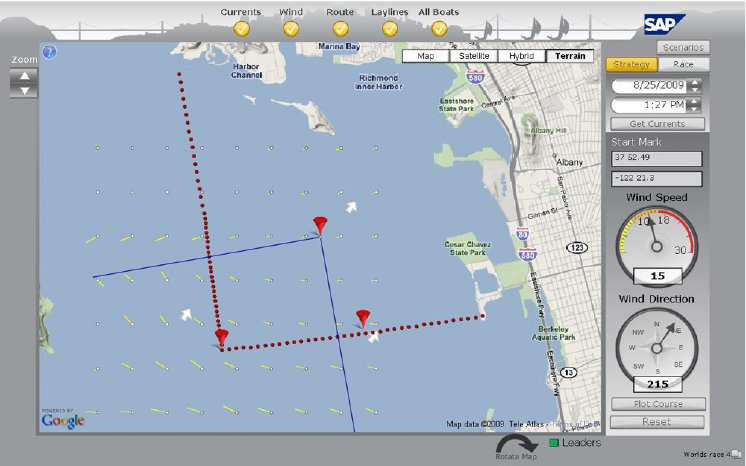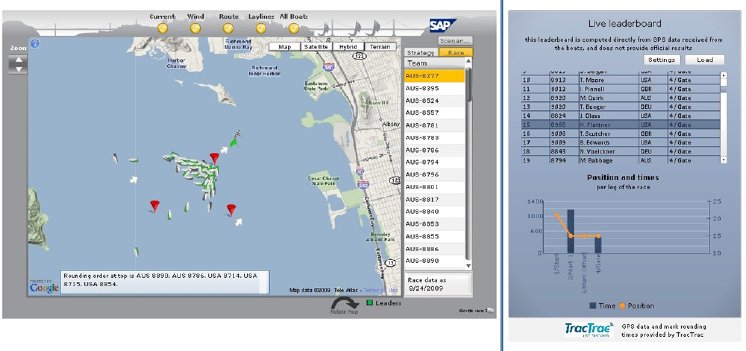"During this race we're seeing firsthand how technology can change the way a sport is played and enrich the total experience," said Kimball Livingston, renowned Bay Area sailor and commentator. "With SAP solutions, we're able to offer racers access to new levels of information and an intuitive, visual way to employ it for competitive advantage. Our spectators can follow the race more closely, evaluate the conditions faced by racers and better predict the outcome. As in business, the more information and insight athletes have, the smarter their decisions and the stronger their performance."
Closing the Gap Between Strategy and Execution: Transforming the 5O5 Race
For the first time, sailors can use an interactive dashboard and mapping system to create a model of the best possible route for each day's race. Their strategy is based on an SAP-created mash-up of Xcelsius®, the SAP data visualization software, combined with Google maps, GPS data, information on winds and currents and a sailing-planning application from third-party providers. By pulling together these data sources and applications via Web services - and adding a layer of data visualization, reporting and analytics - Xcelsius will return a visual, interactive model that shows the most efficient way to reach each turn point under a given set of wind and current conditions. Xcelsius connectivity to Google maps, live GPS racing data, real-time wind and current conditions, as well as navigational software, is provided respectively by software vendors Centigon Solutions, TracTrac and Local Knowledge.
In addition to this BI mash-up, SAP® BusinessObjects(TM) Explorer software, a search and data navigation tool, enables teams to search for and retrieve competitive information on other sailors and that can help them create the winning strategy. Sailors can also look at BI-generated charts to compare competitors' sailing strategies. These reports shows how distance - for instance, a team's chosen course, based on wind and currents data - compares to speed, and sailors' race results.
Kimball Livingston will also be using BI technology from SAP to develop a recommended strategies based upon predictions for current and wind. With the BI mash-up, Livingston will map out optimal routes for contestants before the start of each race. During the race, GPS devices located in all 100 competitors' boats will track their course and racing conditions over each leg of the course, which has five key turn points, with competitors making many smaller, tactical turns between marks. That information will be pulled immediately into the BI mash-up and overlaid on Livingston's proposed course to show how boats are executing against his computer-modeled strategy.
At the end of the day, contestants will be able to review how they fared against their original plan of action, as well as against Livingston's strategy. For example, using SAP BusinessObjects Explorer, competitors will be able to quickly and intuitively navigate through over 200,000 pieces of information per race, including: each boat's position, direction, longitude and latitude, when it rounds each turn, its relative position within the fleet and how it fared on upwind versus downwind legs of the race. By the end of the week-long race there will be over a million rows of data that competitors can comb through to try to better understand their performance. Easy access and navigation of racing data will allow competitors to answer questions they previously did not know how to ask.
With the ability to explore and analyze this data, sailors can check to see how they executed against a given strategy, evaluate strengths and weaknesses in their performance, and use this insight to create a course of action for the next day's race. If there are any gaps between their racing strategy and its execution, teams can identify and close those gaps, helping to ensure optimal performance.
"This will be a learning experience for me too," Livingston said. "I've swallowed a lot of San Francisco Bay over the years, but I've never had such a wide overview of data or this much feedback. And for small-boat racing this is unprecedented."
Easy Access to Timely, Interactive Information: Transforming Spectatorship at the 5O5 Race
The spectator experience for the 5O5 will be enriched by this innovative, unique use of SAP technology. Previously, spectators were not able to follow the race leaders turn-by-turn, as reports have been traditionally available at the end of each day. But now with SAP BusinessObjects BI solutions, spectators can receive real-time information on the leaders online through a Web site, which posts the Xcelsius dashboard, and reports that can be e-mailed to any mobile device. The online Xcelsius dashboard will show contestants' sailboats as they round each turn point, providing additional information on conditions such as current and wind, so spectators can gauge the challenges ahead that can make or break racers' progress. "Leading athletes and CEOs have one thing in common: they both need insight to chart a clear path to success and a way to ensure execution of that strategy," said Jonathan D. Becher, senior vice president, Marketing, SAP. "SAP solutions give people the tools they need to intuitively and intelligently create the right strategy and make sure they stay on track. The 2009 SAP 5O5 World Championship is a perfect example of how better access to data and the ability to track your performance can profoundly change the way you work and help you achieve your goals."
Follow the 5O5 via Twitter and E-mail
To join in the SAP 5O5 conversations on Twitter, tweet to and follow #SAP505. SAP BusinessObjects (@businessobjects) and St. Francis Yacht Club (@StFYC) will be tweeting regularly on the event. To subscribe for turn-by-turn reports, e-mail: SAP5O5raceinfo@sapglobalsponsorships.com.
Any statements contained in this document that are not historical facts are forward-looking statements as defined in the U.S. Private Securities Litigation Reform Act of 1995. Words such as "anticipate," "believe," "estimate," "expect," "forecast," "intend," "may," "plan," "project," "predict," "should" and "will" and similar expressions as they relate to SAP are intended to identify such forward-looking statements. SAP undertakes no obligation to publicly update or revise any forward-looking statements. All forward-looking statements are subject to various risks and uncertainties that could cause actual results to differ materially from expectations. The factors that could affect SAP's future financial results are discussed more fully in SAP's filings with the U.S. Securities and Exchange Commission ("SEC"), including SAP's most recent Annual Report on Form 20-F filed with the SEC. Readers are cautioned not to place undue reliance on these forward-looking statements, which speak only as of their dates.
Copyright © 2009 SAP AG. All rights reserved.
SAP, R/3, mySAP, mySAP.com, xApps, xApp, SAP NetWeaver and other SAP products and services mentioned herein as well as their respective logos are trademarks or registered trademarks of SAP AG in Germany and in several other countries all over the world. All other product and service names mentioned are the trademarks of their respective companies. Data contained in this document serve informational purposes only. National product specifications may vary.

